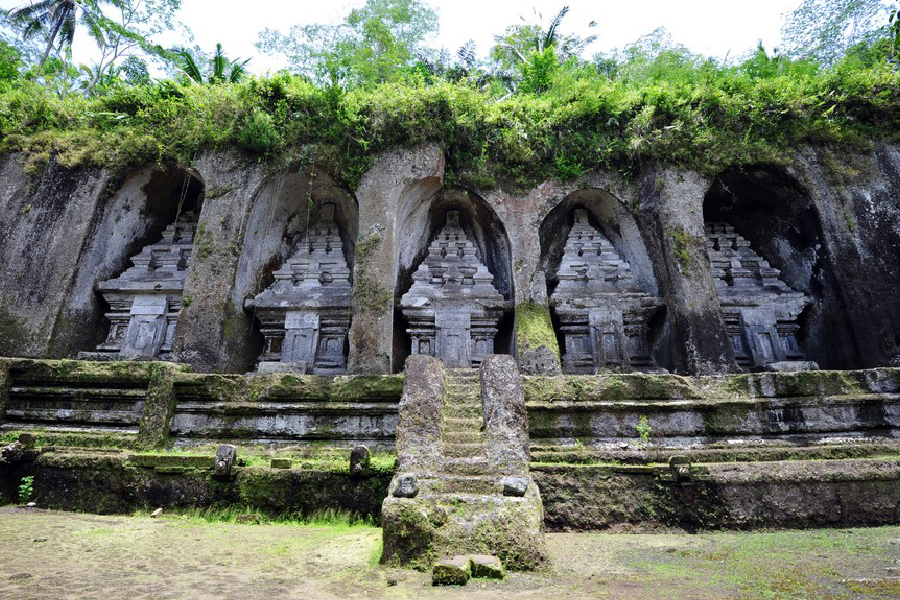Gunung Kawi Temple is located in the village of Tampaksiring, which is about 30-40 minutes’ drive from the popular tourist destination of Ubud. The temple is situated in a lush river valley surrounded by rice paddies and dense jungle, creating a serene and peaceful atmosphere. The journey to Gunung Kawi Temple is an adventure in itself, as visitors drive through winding roads and picturesque landscapes to reach the temple.
The location of Gunung Kawi Temple makes it an excellent choice for travelers looking for a unique and off-the-beaten-path experience in Bali. While the temple may not be as well-known as some of the island’s more famous attractions, its secluded location and rich cultural heritage make it a hidden gem that’s well worth the journey.
Visitors to Gunung Kawi Temple will need to park their vehicles at the top of the valley and walk down a series of steep stairs to reach the temple complex. While the walk can be challenging, it offers visitors a chance to soak in the stunning scenery and appreciate the beauty of the temple from different angles.
The location of Gunung Kawi Temple is a big part of its charm. Tucked away in a quiet corner of Bali, the temple offers visitors a chance to escape the crowds and connect with the natural beauty of the island. Whether you’re a history buff, a nature lover, or simply looking for a unique experience in Bali, Gunung Kawi Temple is definitely worth adding to your itinerary.
At Gunung Kawi Temple, you’ll find a series of ten rock-cut shrines, each measuring 7-meters high, dedicated to the Balinese royal family who ruled the island during the 11th century. The temples are carved into the cliff face of the Pakerisan River, creating a stunning visual spectacle against the backdrop of the surrounding rice paddies and jungle.
But the beauty of Gunung Kawi Temple goes beyond its architectural marvels. The temple is also steeped in history and mythology, making it a fascinating destination for anyone interested in Balinese culture. According to legend, the temple was built by King Anak Wungsu as a tribute to his father, Udayana. The complex was then used as a site for ritual purification ceremonies and as a place of meditation for the Balinese royal family.
To help you plan your visit to Gunung Kawi Temple, we’ve put together this comprehensive guide. We’ll cover everything you need to know, from the best time to visit to insider tips on how to avoid the crowds. Let’s dive in!
Gunung Kawi Temple Location:
Getting to Gunung Kawi Temple
Getting to Gunung Kawi Temple is a straightforward process, and the temple is easily accessible by renting a car with driver or scooter from Ubud. Visitors can expect a scenic 30-40 minute drive through winding roads and lush countryside to reach the village of Tampaksiring, where the temple is located.
Once visitors arrive in Tampaksiring, they will need to park their vehicle and make their way down a series of steep stairs to the temple complex. The walk down to the temple can be challenging for some visitors, but the stunning views of the temple and the surrounding landscape make it well worth the effort.
For those who prefer not to walk, there is an option to take a motorbike taxi from the parking area to the temple complex. However, this option may not be suitable for those who are not comfortable riding on the back of a motorbike.
Visitors to Gunung Kawi Temple can expect a smooth and scenic journey to reach the temple complex, with plenty of photo opportunities along the way.
Best Time to Visit Gunung Kawi Temple
The best time to visit Gunung Kawi Temple is during the early morning or late afternoon when the light is soft, and the crowds are thinner. During these times, visitors can enjoy a more peaceful and intimate experience, as they can take their time to explore the temple complex without feeling rushed.
Visiting during midday can be challenging due to large crowds and hot temperatures, which can make the walk down to the temple complex more difficult. Therefore, it’s best to avoid visiting during this time if possible.
The temple is open daily from 7:00 am to 5:00 pm, with the last entrance at 4:30 pm. Visiting early in the morning is a great way to beat the crowds and enjoy the temple in a more serene atmosphere. Moreover, visitors can witness the sun rising over the temple, creating a stunning and unforgettable view.
The best time to visit Gunung Kawi Temple is during the early morning or late afternoon when the crowds are smaller, the light is soft, and the temperatures are more manageable. By visiting at the right time, visitors can fully appreciate the temple’s beauty and serenity without feeling rushed or overwhelmed.
 What to Wear to Gunung Kawi Temple
What to Wear to Gunung Kawi Temple
When visiting Gunung Kawi Temple, it’s important to dress appropriately as a sign of respect to the temple and its cultural significance. As with most temples in Bali, visitors are expected to dress modestly, covering their shoulders and knees, and avoiding tight or revealing clothing.
Lightweight, breathable clothing is recommended, especially during hot and humid weather conditions. Visitors should also consider wearing comfortable walking shoes with good traction, as the walk down to the temple complex can be slippery and uneven.
It’s also essential to bring a sarong or a scarf to cover up when entering the temple. These items can be rented or purchased on-site, but it’s advisable to bring your own to avoid additional costs.
Furthermore, visitors should avoid wearing any clothing with political or offensive slogans, as this is considered disrespectful and inappropriate in a sacred place like Gunung Kawi Temple.
Visitors should dress respectfully, covering their shoulders and knees, and avoiding tight or revealing clothing. Lightweight, breathable clothing, comfortable walking shoes, and a sarong or scarf to cover up are recommended. By dressing appropriately, visitors show respect for the temple’s cultural significance and can fully appreciate its beauty and serenity.
Photography Tips for Gunung Kawi Temple
Gunung Kawi Temple is a photographer’s paradise, with its picturesque river valley backdrop and stunning rock-cut temples. To capture the beauty of the temple complex, it’s important to come prepared with the right equipment and techniques.
First and foremost, bring a wide-angle lens to capture the grandeur of the temple complex and its surroundings. A tripod is also essential to keep your camera steady, especially when shooting in low light conditions. A polarizing filter can help reduce glare on the water and bring out the colors of the surrounding foliage.
When photographing the temple complex, try to capture different angles and perspectives to showcase its intricate details and unique architecture. Don’t be afraid to get creative and experiment with composition and framing.
It’s also important to be respectful of the temple and its visitors while taking photos. Avoid using flash photography and be mindful of others who may be praying or meditating. And as always, be sure to ask for permission before taking photos of people, especially locals.
With these photography tips in mind, you’ll be able to capture stunning images of Gunung Kawi Temple and its surroundings to cherish for years to come.
Hiking to Gunung Kawi Temple
For those seeking a more adventurous way to reach Gunung Kawi Temple, hiking is a great option. The trail is an excellent opportunity to immerse yourself in Bali’s lush countryside while enjoying some light exercise. The trek to the temple is not too long, but it is moderately challenging, with steep stairs and uneven terrain. The hike begins at the village of Tampaksiring and takes you through beautiful rice paddies and jungle, offering stunning views of the surrounding landscape.
As with any hike, it’s essential to wear appropriate shoes and clothing. We recommend wearing sturdy hiking shoes or sneakers with a good grip, as the trail can be slippery in some areas. It’s also important to wear lightweight, breathable clothing to stay cool in Bali’s tropical climate. Don’t forget to bring plenty of water to stay hydrated along the way.
Hiking to Gunung Kawi Temple can be an enjoyable way to escape the crowds and experience Bali’s natural beauty. However, it’s important to note that the trail can be challenging, so it’s not suitable for everyone. If you have mobility issues or health concerns, we recommend sticking to the stairs or hiring a local guide to assist you.
Ticket Prices and Hours of Operation
Tickets to Gunung Kawi Temple cost IDR 50,000 per person, which is roughly equivalent to USD 3,5. The ticket price includes entry to the temple complex and access to the parking area. The ticket booth is located at the top of the stairs leading down to the temple, so be sure to purchase your tickets before making the descent.
The temple is open daily from 7:00am to 5:00pm, with the last entry at 4:30pm. We recommend arriving early to beat the crowds and the heat. If you visit during the midday heat, the walk down to the temple complex can be challenging, so be sure to bring plenty of water and take frequent breaks.
Note that there are additional fees for parking your vehicle. If you’re traveling by scooter, expect to pay a small fee for parking, while cars may be charged slightly more. There are also vendors selling snacks and drinks near the parking area, so you can stock up before making the descent to the temple.
Check also: Uncover the Unearthly Charm of Kanto Lampo Waterfall in Bali



2 Replies to “Journeying through Bali’s Past – A Visit to Gunung Kawi Temple”